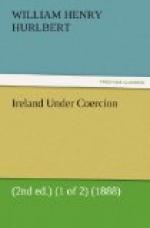It is provoking to know that the notes taken by this British officer at that time, being sent through the Post Office by him some years ago to Edinburgh for publication, were lost in the transmission, and have never been recovered. Curiously enough, however, he thinks he has now and then discerned indications in articles upon the American War, published in a newspaper which he named, going to show that his manuscripts are in existence somewhere.
ABBEYLEIX, Monday, Feb. 13.—To-day, in company with Lord de Vesci and a lady, I went over to Kilkenny. We left and arrived in a snowstorm, but the trip was most interesting. Kilkenny, chiefly known in America, I fear, as the city of the cats, is a very picturesque place, thanks to its turrets and towers. It has two cathedrals, a Bound Tower (one of these in Dublin was demolished in the last century!), a Town Hall with a belfry, and looming square and high above the town, the Norman keep of its castle. The snow enlivened rather than diminished the scenic effect of the place. Bits of old architecture here and there give character to the otherwise commonplace streets. Notable on the way to the castle is a bit of mediaeval wall with Gothic windows, and fretted with the scutcheon in stone of the O’Sheas. The connection of a gentleman of this family with the secret as well as the public story of the Parnellite movement may one day make what Horace Greeley used to call “mighty interestin’ reading.” A dealer in spirits now occupies what is left of the old Parliament House of Kilkenny, in which the rival partisans of Preston and O’Neill outfought the legendary cats, to the final ruin of the cause of the Irish confederates, and the despair of the loyal legate of Pope Innocent.
Of Kilkenny Castle, founded by Strongbow, but two or three towers remain. The great quadrangle was rebuilt in 1825, and much of it again so late as in 1860. There is little, therefore, to recall the image of the great Marquis who, if Rinuccini read him aright, played so resolutely here two centuries and a half ago for the stakes which Edward Bruce won and lost at Dundalk. The castle of the Butlers is now really a great modern house.
The town crowds too closely upon it, but the position is superb. The castle windows look clown upon the Nore, spanned by a narrow ancient bridge, and command, not only all that is worth seeing in the town, but a wide and glorious prospect over a region which is even now beautiful, and in summer must be charming.
Over the ancient bridge the enterprise of a modern brewer last week brought a huge iron vat, so menacingly ponderous that the authorities made him insure the bridge for a day.
Within the castle, near the main entrance, are displayed some tapestries, which are hardly shown to due advantage in that position. They were made here at Kilkenny in a factory established by Piers Butler, Earl of Ormonde, in the sixteenth century, and they ought to be sent to the Irish Exhibition of this year in London, as proving what Irish art and industry well directed could then achieve. They are equally bold in design and rich in colour. The blues are especially fine.




